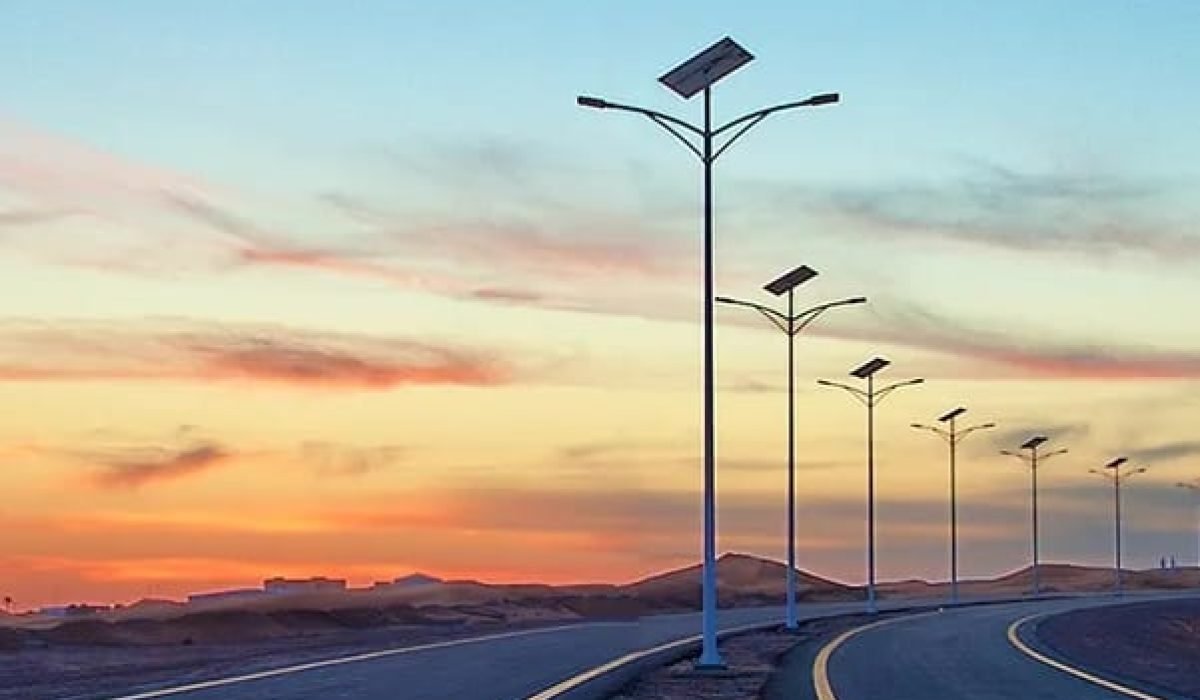Why is this West Africa solar street light project important?
In 2023, our company supplied and installed 500 sets of 7-meter poles with 60 W solar street lights in West Africa. Now, after one full year of use, the results are clear and can help other governments and EPC contractors when preparing future projects. The project was requested by a municipal government that wanted reliable street lighting without depending on unstable grid power. Their goals were simple: long service life, guaranteed lighting every night, and reduced maintenance costs.
The one-year operation shows that these lights met the targets and even performed better than expected.
How was the system designed?
The design used simple but proven components to balance cost and performance:
- Pole: 7 m hot-dip galvanized steel poles, tested to EN 40 and ISO 1461, anti-rust lifespan 20–25 years
- LED: 60 W module, high efficiency ≥ 230 lm/W, producing 13,800 lumens
- Battery: LiFePO₄, cycle life ≥ 6000 times, tested by IEC 62619
- Controller: MPPT with dimming curve for energy saving at midnight
- Protection: IP66 waterproof, IK08 impact resistant
- Packaging: Passed ISO 2234 and ISTA 1A transport drop tests
Each light was delivered as a complete one-to-one system. No grid trenching, no wiring delays. Average installation time was 35 minutes per unit.
What results were achieved after one year?
We carried out site inspections and collected user feedback. The data below shows real performance:
| Indicator | Tender Requirement | Measured After 12 Months |
|---|---|---|
| Lighting duration per night | ≥ 12 hours | 12–14 hours (even during rainy season) |
| Backup autonomy | 3 nights without sun | 3.2 nights average |
| LED efficiency | ≥ 210 lm/W | 230 lm/W stable |
| Battery capacity retention | ≥ 90% | 94% after 1 year |
| Pole condition | No visible rust | Passed, no corrosion |
| Maintenance rate | < 2% failure | 1.2% minor adjustments |
Why did the government select solar instead of grid lighting?
From the buyer’s side, three factors made solar the better option:
- Budget: No monthly electricity bills. One-time investment only.
- Speed: Installation finished in 7 weeks. Faster than waiting for grid extension.
- Reliability: Lights continued to work during grid blackouts and rainy season.
This gave officials clear proof that solar can provide stable and safe lighting at predictable cost.
What problems appeared during the first year?
Not every unit worked perfectly. The following challenges were recorded:
- Dust on panels reduced charging by 8–10% during dry season. A cleaning plan every 3 months solved this.
- 5 cases of vandalism in rural areas. Extra anchor bolts and GPS tags for batteries were added.
- Spare parts took time to reach remote towns. A local stock point was later opened.
With these measures, uptime was kept above 98% across all 500 units.
How did the project help the local community?
Feedback from both the municipality and local people showed clear benefits:
- Safety: Police data recorded 37% fewer road incidents at night.
- Business: Market sellers extended evening trade hours by 2–3 hours.
- Government trust: Citizens saw visible improvement in public services.
This impact went beyond lighting. It supported economic activity and improved the city’s image.
What comes next after this first phase?
The Ministry of Energy is now preparing the second stage: an expansion to 2,000 units. Tender rules will include stricter compliance:
- Battery passport data in line with EU Regulation 2023/1542
- Cycle life test reports ≥ 6000 times
- IEC and ISO certificates included in tender folder
- Local training for O&M teams
This structure helps shorten evaluation time and makes financing approval easier.
What should EPC contractors learn from this case?
- 60 W with 7 m pole is a practical standard for city and secondary roads in West Africa.
- LiFePO₄ batteries with 6000 cycles are still the safest and most accepted option.
- Full compliance files (IEC, ISO, UN38.3, battery passport) reduce tender risk.
- After-sales planning such as spare parts and cleaning schedules keeps uptime above 98%.
Why this matters for future projects
The West Africa case proves that solar street lights can meet government expectations if the design is correct and compliance is complete. Success in tenders does not come only from low price but from delivering a reliable and well-documented solution.
📩 For detailed specifications, compliance files, and project appendices, contact Sunlurio. These resources can help your tender stand out and win.
Project process flow: From tender to one-year results
timeline
title West Africa Solar Street Light Project
Feb 2023 : Tender Released
Mar 2023 : Technical Evaluation
Apr 2023 : Contract Signed
May–Jun 2023 : Manufacturing & Testing
Jul 2023 : Shipment & Customs Clearance
Aug 2023 : Installation Completed
Feb 2024 : 6-Month Inspection
Aug 2024 : 12-Month Report with Results


